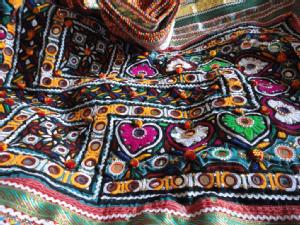Bayiyabai Umra Kharet
|
Bayiyabai Umra Kharet Age: 40 Education: None Place of residence: Hodko Date: 29/5/2012 |
Interview Summary
Bayiya Bai was between 8 and 10 years when she started learning needlework; she learnt from her mother Manbai. She says she is not educated as there were no schools nearby where she grew up. Neither her daughter nor her granddaughter went to school too. The family live a semi-nomadic life. Before her 27 to 28 years of marital life, she lived in Gholibari.
The materials needed for the needlework: thread and cotton cloth, is brought from Bhuj. Bayiya Bai, in an irritable tone, says that the needlework is very painful to the eyes but yet does not guarantee a regular income. Customers do not necessarily value the work and often find the prices of many pieces exorbitant. Bayiya Bai said that even cutting wood can be more profitable on a day-to-day basis. When the investment in materials is taken into account too, needlework is not particularly profitable.
She is proficient in embroidery (bharat) work in particular and told us about many different kinds of embroidery, including as pakko bharat, kharek, katri, nain bharat, chopad andkachchho bharat. Talented Bayiyabai also knows katab work, or appliqué, which is created by cutting the cloth with scissors, followed by needlework. Baiya bai has done astonishing amount of work during her lifetime. She says that some of the work on which she has worked so hard, she is so proud of that she will never actually sell it, even if she was offered 10,000 rupees. According to her, it takes two years to make an embroidery masterpiece. Explaining the difference between the pakko(final) and kacho(rough) her husband Umra Kana says that pakkois more complicated than the kachoand it is a time-consuming design. Accordingly, kachocan be completed in just 15 days time whereas for the pakkoa month’s time is required. Whenever these women are free from the household work they will do embroidery. They get a little time for the needlework though due to the demands of domestic life. Although she is not a Muttwa, Bayiya knows Muttwa work well having had regular contact with the community. The chopadembroidery can be painful (daukhiyo) to the eyes. When they feel too much strain in the eyes they simply splash them with water. They are not aware of eating foods rich in Vitamin A such as carrot and coriander to keep their eyes healthy. The local Muttwa and Sama communities have largely left wearing their traditional dress, but they have retain some elements of its design and style. Interestingly, she adds that ‘jug mandhao tadunu halyo ache’ - their dress has been in vogue since the creation of the world. In former times they also wore ivory bangles. Their main garments are kanjari (blouse) pheran andpado(lower garment). The dresses they wear were previously handmade but are now machine-made. They have had led a poor life in the past, but now it has improved. One important difference between the Muttwa embroidery work and that of the Marwadas is the use of designs and mirror work. In the Muttwa work, small mirrors called ticklaare frequently used.
In September 2005, she was invited to Paris for a month and was highly honoured, in her words, in ‘an unbelievable manner’. She felt overwhelmed with such a reception. Her husband adds that they have visited places such as Delhi and Mumbai. The tourists who visit them purchase the embroidered kanjari and female tourists often make beautiful kurti (tops) from it.
However, even after making such many excellent pieces of needlework and being celebrated in France, the family are disheartened by the fact that Bayiya was actually denounced for visiting a foreign country by her community. Umra and family have become relatively progressive in thinking after coming in contact with foreigners. That has created a clash between their family and the caste. Unfazed by such a criticism, Umra insists that the sale of embroidery work to foreigners and their foreign contacts has, ultimately, brought bread and butter to his family.
At present, Bayiya is making a wedding trousseau for her daughter. Along with that, in their community, giving bags loaded with embroidered dresses and bags for the bridegroom and his family is an important social convention. It is also essential that they give around forty to fifty embroidered quilts to their daughter. If a bride fails to bring with her traditionally set trousseau and quilts she is frowned upon. The bride also brings an embroidered bhabhjikothari in which groom takes the satamjaladdoo (sweets) for his in-laws. They, like other Marwadas, believe in saint Ramdev Pir and do not pick up the needle on special days such as Shitala satam and Shitala teras (seventh or thirteenth day of the full moon, or blue moon devoted to the Goddess Shitla) andumas (blue moon day).
Bayiya Bai’s family has retained a twenty to twenty-five year old collection of embroidery work. According to their knowledge, the craft has been followed for 100 to 150 years. They see it as something that is in their blood, and for them, the designs, colour combinations, and the imagination needed to combine them, comes naturally. The names of the designs derive from the community’s way of life. The nain design, for instance, is based on the shape of the eyebrows, while the paniyari depicts a girl who carries water on her head. Bayiya Bai told us that her mother is eighty years old and is an expert in making the hardest type of embroidery known as suf bharat, which involves both obverse and reverse stitches. The women who know this complex type of embroidery are identified as (hoshiyar), some of the most intelligent ones in the community. Umra Kana claims that although most of the males from his community would not know needlework but he is quite acquainted with several stitches and can stitch quilts.

